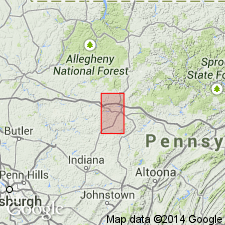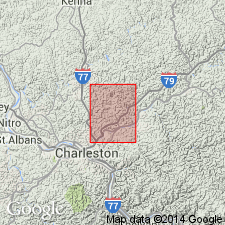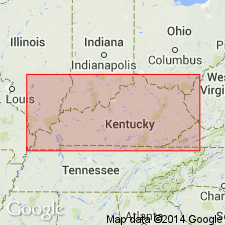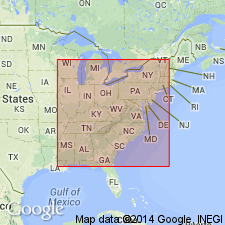
- Usage in publication:
-
- Conemaugh series
- Modifications:
-
- Named
- Dominant lithology:
-
- Sandstone
- AAPG geologic province:
-
- Appalachian basin
Summary:
First use of Conemaugh series. Shown in table. Composed of Middle Barren Measures and underlying Mahoning sandstone. Conemaugh underlain by Allegheny series; overlain by Monongahela series.
Source: GNU records (USGS DDS-6; Reston GNULEX).

- Usage in publication:
-
- Conemaugh Formation*
- Modifications:
-
- Revised
- AAPG geologic province:
-
- Appalachian basin
Summary:
Two new formal members named within the Conemaugh Formation in the Big Chimney quadrangle (Kanawha Co., WV): the Sandy Grove Sandstone Member and the Pocatalico Sandstone Member. The Conemaugh Formation in the Big Chimney quadrangle consists of a lower unnamed member, the Sandy Grove Sandstone Member, a middle unnamed member, the Pocatalico Member, and an upper unnamed member.
Source: GNU records (USGS DDS-6; Reston GNULEX).

- Usage in publication:
-
- Conemaugh Group
- Modifications:
-
- Revised
- AAPG geologic province:
-
- Appalachian basin
Summary:
Conemaugh Group in OH has not been divided into formations. The base of the Conemaugh is marked by the Upper Freeport coal and the top by the Pittsburgh coal. In this report, the Conemaugh is informally divided into ascending Brush Creek, Cambridge, Portersville, and Ames marine zones, which are roughly equivalent to the formal marine members of the Glenshaw Formation of WV. These zones range from a few meters to a few tens of meters in thickness. They have sharp bases, poorly defined tops, and were deposited under nearly continuous marine to brackish-water conditions. They are typically overlain by fluvial sandstones or paleosols. Nomenclature here is called a "working stratigraphy" and is provisional pending revision of the Pennsylvanian System in OH.
Source: GNU records (USGS DDS-6; Reston GNULEX).

- Usage in publication:
-
- Conemaugh Formation
- Modifications:
-
- Overview
- AAPG geologic province:
-
- Appalachian basin
Summary:
The Conemaugh and overlying Monongahela Formations were recorded only in the Allegheny synclinorium (Parkersburg syncline) in the northern portion of the study area. There they overlie the newly named Princess Formation of the Breathitt Group.
Source: GNU records (USGS DDS-6; Reston GNULEX).
- Usage in publication:
-
- Conemaugh Formation*
- Modifications:
-
- Revised
- AAPG geologic province:
-
- Appalachian basin
GNU Staff, 1992, Advance copy of Merrill, G.K., and Dutro, J.T., Jr., The Kenova Limestone Member, Conemaugh Formation (Pennsylvanian, Missourian), northwestern West Virginia, USGS Bull. XXXX (unpublished): U.S. Geological Survey Digital Data Series, DDS-6, 1 CD-ROM., release 3
Summary:
Revised the Conemaugh Formation in West Virginia to include the Kenova Limestone Member at the base of the formation. The Kenova Limestone Member is named for Kenova, Wayne Co., northwestern WV. Consists of pinkish, fossiliferous limestone masses within a sequence of sandstones and conglomerates. Unit occurs as a channel at the base of the Conemaugh Formation and has only been recognized at its type section. The Kenova Limestone Member is inferred to be a marine estuarine deposit, possibly representing a thalweg at the topographically lowest part of a delta that was effected by a marine transgression. Unit overlies the Allegheny Formation and underlies the Brush Creek Limestone Member of the Conemaugh Formation. Conodont fauna indicate that the Kenova is of Late Pennsylvanian (early Missourian) age.
Source: GNU records (USGS DDS-6; Reston GNULEX).
- Usage in publication:
-
- Conemaugh Group, Formation
- Modifications:
-
- Overview
- AAPG geologic province:
-
- Appalachian basin
GNU Staff, 1992, GNU Staff remark.: U.S. Geological Survey Digital Data Series, DDS-6, 1 CD-ROM., release 3
Summary:
Many subunits, both formal and informal, have been designated for the Conemaugh Group and Conemaugh Formation in various states. The following lists for the various states are many of the formal units. . In Pennsylvania, the Conemaugh Group* consists of (alphabetically) the Casselman Formation* and the Glenshaw Formation*; the Conemaugh Formation* consists of the Bakerstown Sandstone Member, Birmingham Shale Member*, Brush Creek Limestone Member*, Buffalo Sandstone Member*, Connellsville Sandstone Member*, Elk Lick Limestone Member*, Ewing Limestone Member*, Grafton Member, Lower Mahoning Sandstone Member, Mahoning Sandstone Member*, Morgantown Sandstone Member*, Round Knob Shale Member, Saltsburg Sandstone Member*, Summerhill Sandstone Member*, Uffington Shale Member*, and Wilmore Sandstone Member*. . In Maryland, the Conemaugh Group* consists of the Casselman Formation* and Glenshaw Formation*; the Conemaugh Formation* consists of the Ames Limestone Member*, Brush Creek Limestone Member*, Buffalo Sandstone Member*, Cambridge Limestone Member*, Clarksburg Limestone Member, Mahoning Sandstone Member*, Morgantown Sandstone Member*, and Saltsburg Sandstone Member*. . In West Virginia, the Conemaugh Group consists of the Casselman Formation and Glenshaw Formation; the Conemaugh Formation* consists of the Ames Limestone Member*, Brush Creek Limestone Member*, Buffalo Sandstone Member*, Cambridge Limestone Member*, Clarksburg Limestone Member*, Connellsville Sandstone Member, Ewing Limestone Member, Kenova Limestone Member, Mahoning Sandstone Member*, Mason Shale Member, Morgantown Sandstone Member*, Pine Creek Limestone Member, Pocatalico Sandstone Member*, Saltsburg Sandstone Member, Sandy Grove Sandstone Member*, Twomile Limestone Member, Uffington Shale Member*. . In Ohio, the Conemaugh Group consists of the Ames Limestone, Gaysport Limestone, Portersville Limestone, and Skelley Limestone; the Conemaugh Formation* consists of the Ames Limestone Member*, Bakerstown Member, Barton Shale Member, Bellaire Sandstone Member, Birmingham Shale Member*, Brush Creek Limestone Member, Buffalo Sandstone Member*, Cambridge Limestone Member*, Clarksburg Limestone Member, Connellsville Sandstone Member, Elk Lick Limestone Member*, Ewing Limestone Member*, Mahoning Sandstone Member*, Mason Shale Member, Morgantown Sandstone Member*, Noble Limestone Member, Portersville Limestone Member, Rock Riffle Limestone Member, Round Knob Shale Member, Saltsburg Sandstone Member*, Skelley Limestone Member. . In Kentucky, the Conemaugh Formation* consists of the Ames Limestone Member*, Brush Creek Limestone Member*, and Cambridge Limestone Member*.
Source: GNU records (USGS DDS-6; Reston GNULEX).

- Usage in publication:
-
- Conemaugh Formation*, Group*
- Modifications:
-
- Overview
- AAPG geologic province:
-
- Appalachian basin
Summary:
Conemaugh Formation is used in PA, OH, WV, MD, and KY. Where Ames Limestone Member is present, Conemaugh is raised to group rank and divided into lower Glenshaw Formation (with its Ames Limestone Member) and upper Casselman Formation. Locally in OH, Conemaugh series (old usage) was divided into 15 cyclothems (ascending): Mahoning, Mason, Lower Brush Creek, Upper Brush Creek, Wigus, Anderson, Upper Bakerstown, Harlem, Ames, Gaysport, Duquesne, Elk Lick, Little Clarksburg, Lower Little Pittsburgh, Upper Little Pittsburgh; each name is derived from a named coal or limestone included in the cyclothem. Includes Mahoning Sandstone member in MD (in PA and OH, Mahoning is a formal member of Glenshaw Formation). Assignment of Mahoning sandstone to Conemaugh Formation by Krebs and Teets (1914) is incorrect; reassignment of Mahoning to Charleston Sandstone by Englund and others (1979) is also probably incorrect. Conemaugh also includes Saltsburg Sandstone Member in PA, MD, OH, and WV, and Brush Creek Limestone member in PA, WV, OH, and KY) [not all subdivisions of Conemaugh are listed in report].
Source: GNU records (USGS DDS-6; Reston GNULEX).
For more information, please contact Nancy Stamm, Geologic Names Committee Secretary.
Asterisk (*) indicates published by U.S. Geological Survey authors.
"No current usage" (†) implies that a name has been abandoned or has fallen into disuse. Former usage and, if known, replacement name given in parentheses ( ).
Slash (/) indicates name conflicts with nomenclatural guidelines (CSN, 1933; ACSN, 1961, 1970; NACSN, 1983, 2005, 2021). May be explained within brackets ([ ]).

